A Celebration 50 Years in the Making
In a two-day event commemorating the 50th anniversary of SLAC National Accelerator Laboratory, about 1,000 employees, former employees and university, government and scientific leaders celebrated the lab's successes and looked ahead to the next great challenges.
By Glenn Roberts Jr.
In a two-day event commemorating the 50th anniversary of SLAC National Accelerator Laboratory, about 1,000 employees, former employees and university, government and scientific leaders celebrated the lab's successes and looked ahead to the next great challenges.
The event, which began with a daylong scientific symposium Friday exploring research opportunities for the lab's next half century, continued Saturday with tours and a barbecue luncheon and live band on the main quad for current and retired employees and their families.
It culminated with an anniversary ceremony featuring remarks by Energy Secretary Steven Chu, Stanford University President John Hennessy, SLAC's current and former directors and other distinguished guests.
"Today is not just about honoring our very distinguished, great past, but about celebrating where we are today and the contributions that so many of you have made to the history of this laboratory,” SLAC Director Persis Drell told the audience assembled on a field overlooking the lab’s flagship project, the Linac Coherent Light Source (LCLS) X-ray laser facility.
"Today is about looking to the future of this laboratory and the discoveries yet to be made,” she said. “And many of you in the audience are going to be part of making those discoveries happen."
Drell noted that the two-mile-long linear accelerator made possible by the vision of SLAC's founding director, the late Wolfgang "Pief" Panofsky, not only proved itself a world-leading tool 50 years ago – it now powers the LCLS, the world's most powerful X-ray laser. "That is an astounding legacy,” she said.
Chu, a Nobel Prize-winning, former Stanford University professor who served as director of Lawrence Berkeley National Laboratory until his 2009 call to lead the DOE, recognized important historic and modern scientific contributions by SLAC and Stanford scientists. He also detailed a range of scientific priorities and challenges.
"I can't pretend to know what will happen in the next 50 years, and if we did that would be very disappointing," Chu said. “We can count on the fact that there will be a whole lot of surprises."
Several speakers documented the lab's longstanding and continuing transformations in dogged pursuit of new discoveries and new fields of research, and credited the lab's founders as visionaries who pushed technological innovation in their explorations of the unknown and set a high bar for their successors.
Hennessy, who joined Stanford's faculty in 1977 and became the university's 10th president in 2000, noted the longstanding collaboration between researchers at the university and the lab, which enabled a series of important and groundbreaking scientific firsts.
"We share a compelling mission in the discovery and dissemination of new knowledge, and our close proximity has allowed us to work together in a way that simply wouldn't be possible if we were not co-located," Hennessy said.
"For five decades, SLAC – its directors, researchers and staff – have charted new paths, advancing the frontiers of both theoretical and applied knowledge, while finding new ways to collaborate and innovate," he said. "SLAC has served as a magnet for researchers around the world. It is this coming together of talented and driven researchers that has made SLAC such an incredible source for such great advances in science."
Several elected officials also joined in celebrating the lab's 50-year history, including U.S. Reps. John Garamendi and Anna Eshoo. At Saturday's ceremony, Eshoo credited SLAC for "enormous and lasting contributions in the field of science and technology," over its history.
"I believe, in our great nation, that science is our masterpiece and innovation is our art," she said. "This is not only SLAC's golden anniversary, it's also its golden age. I have deep and abiding regard for what science and research have contributed to American leadership."
The nation must prioritize science in the years to come, she added. "The 21st century must be marked by three things: science, science and science."
Jonathan Dorfan, SLAC director from 1999-2007, and Burton Richter, who led the lab from 1984-99, reflected on the lab's achievements and diversifying mission.
Dorfan said SLAC's history "is one of invention driven by really great ideas," and it has "always been underpinned by a thirst to do groundbreaking science."
"Labs at standstill become obsolete,” Richter asserted. “SLAC's never stood still, either in its accelerators or in its science."
Richter's participation in early particle physics experiments at the lab won him a Nobel Prize in Physics in 1976. "We set off to change science and did," he said, adding that SLAC "is still changing science both in the original mission and in much broader areas, too."
Event attendees said they enjoyed the chance to catch up with current colleagues and old friends; and longtime employees and retirees reminisced about their contributions to the lab's storied science projects.
Hartmut Sadrozinski, research physicist and adjunct professor for the Santa Cruz Institute for Particle Physics, said, "This is like old soldiers meeting." A SLAC collaborator and facilities user for decades, Sadrozinski said he has worked on a handful of particle physics projects and collaborated on the Fermi Gamma-ray Space Telescope’s main instrument, in which the lab plays a key role.
Collaborations "are one of the great things about science," said Sadrozinski, also on faculty in the physics department at the University of California-Santa Cruz. "You develop personal relationships. You develop science relationships."
Claudio Pelligrini, an X-ray free-electron laser pioneer who was an early proponent of the LCLS project, also said he enjoyed the opportunity to reconnect with colleagues and friends at the event. As for the future of science at SLAC: "A lot of things have been done – a lot of things to do.”
At Friday’s symposium, scientists detailed emerging research frontiers that SLAC is well positioned to investigate, from particle discoveries beyond the Higgs boson, to explorations of the abundant dark matter that hides in plain sight throughout the universe, and the latest innovations in biological imaging at the atomic scale.
Speakers noted the latest discoveries, proposals for new and improved facilities that will expand the bounds of research for decades to come, and opportunities for merging multiple disciplines – including cosmology, astrophysics and particle physics – in pursuit of common scientific goals. Hundreds of guests attended the symposium sessions, which were simultaneously broadcast on site for lab employees and taped for later release on the Web.
As the symposium’s keynote speaker on Friday, Energy Secretary Chu commented on the scientific opportunities made possible in crises such as global warming. "We must accelerate the transition to affordable and sustainable energy that will power economic growth, increase energy security and mitigate the risks of climate change," he said. "We've got a lot of brainpower in the United States. We should be taking advantage of this opportunity."
Later that night, during a special Friday dinner at Stanford University, Sidney Drell, a former SLAC deputy director, recognized Pief Panofsky's leadership at SLAC.
"Pief would have been very pleased and proud to hear the discussions and talks at today's symposium," said Drell, a senior fellow at Stanford's Hoover Institution since 1998 and a former president of the American Physical Society. "This would have been beautiful music, all of this, to Pief's ears."
He continued, "Pief's vision remains deeply planted in the culture at SLAC, and it has been nurtured well, also, by his successors, and it will guide us to the future as we insist upon our role standing at the frontier of science as it broadly advances."
SLAC's "aggressive reinvention has remained clear and strong," he said.
Helmut Dosch, director of DESY, a national laboratory in Germany that has had close ties with SLAC, said he has witnessed his own lab and SLAC undergo an at-times "painful transition" in scientific mission, which he said has been well-navigated.
"Only a smart laboratory remains a living laboratory,” Dosch said. "I wish SLAC, for the future, to continue its comet-like orbit in the scientific sky, to remain a place which is a host of different scientific disciplines to continue to be an interactive platform for new ideas, and to remain – despite the need for long-term planning – a place of serendipity."
Also at the dinner, Barry C. Barish, past president of the American Physical Society and an emeritus physics professor at the California Institute of Technology, presented a plaque recognizing SLAC as a historic site for its many groundbreaking discoveries in science.
The plaque states:
In recognition of the SLAC National Accelerator Laboratory, formerly Stanford Linear Accelerator Center, established in 1962 and home of the 2-mile Stanford Linear Accelerator and the SPEAR electron storage ring. These two accelerators played instrumental roles in the discovery of quarks, the establishment of the Standard Model of particle physics, and the invention and use of high-brightness X-ray synchrotron and laser sources for the study of solid-state materials, surfaces, and biological structure.
Barish, a former SLAC researcher, said the award recognizes a SLAC tradition "to combine innovative, new, ambitious facilities to perform groundbreaking experiments that have proven to lead to important discoveries.”
SLAC, he said, "is a place where great scientists have been able to do great science."
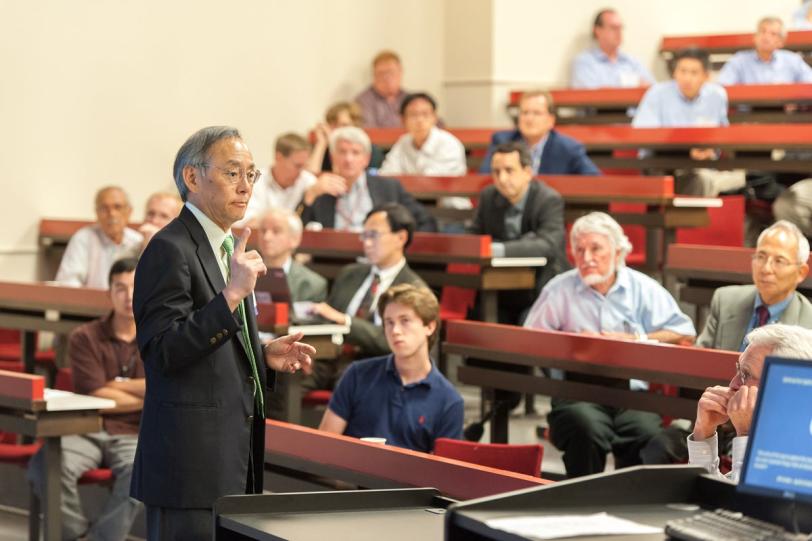
(Photo by Matt Beardsley)
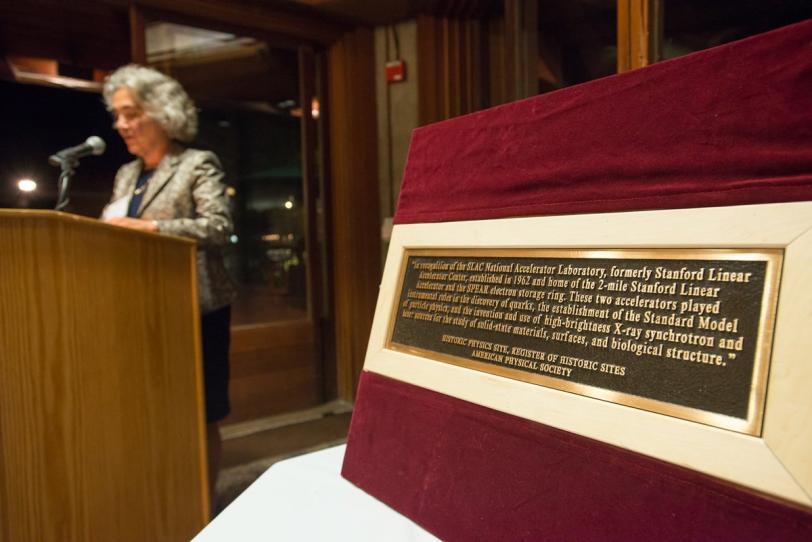
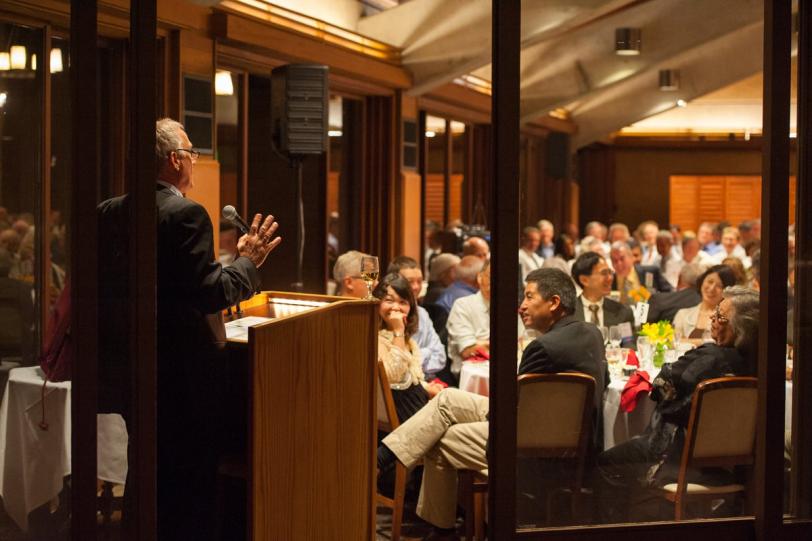
(Photo by Matt Beardsley)
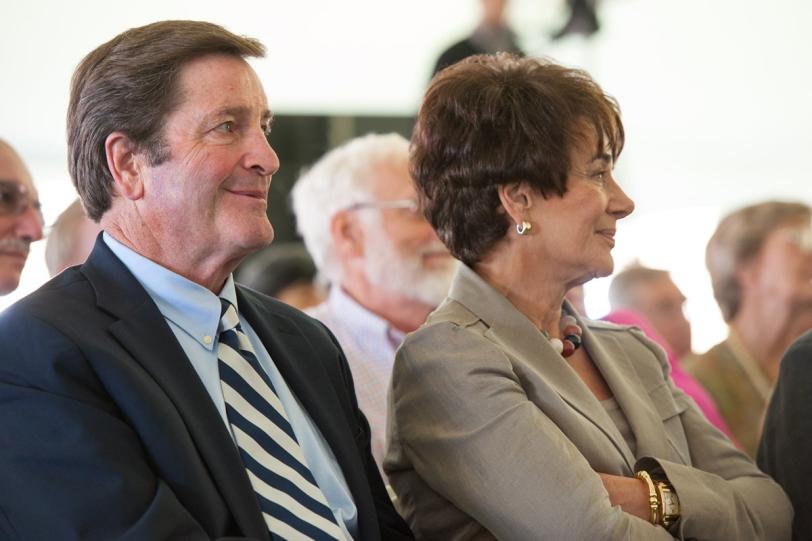
(Photo by Matt Beardsley)
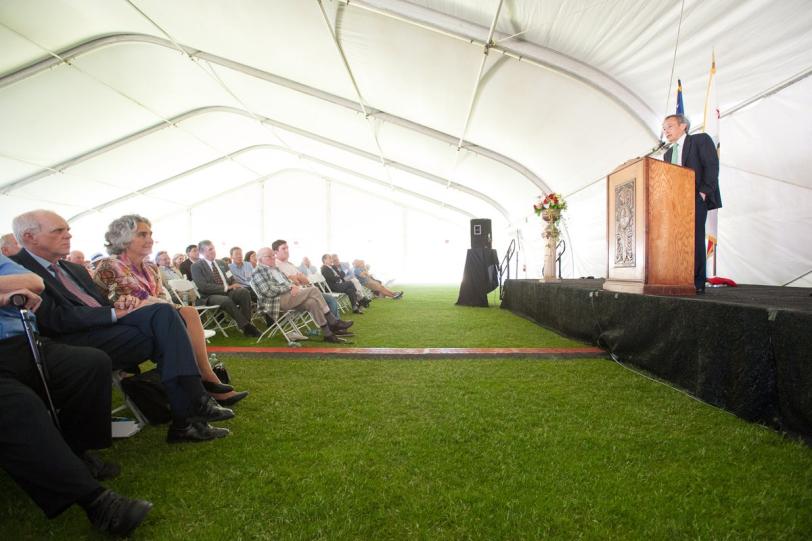
(Photo by Matt Beardsley)
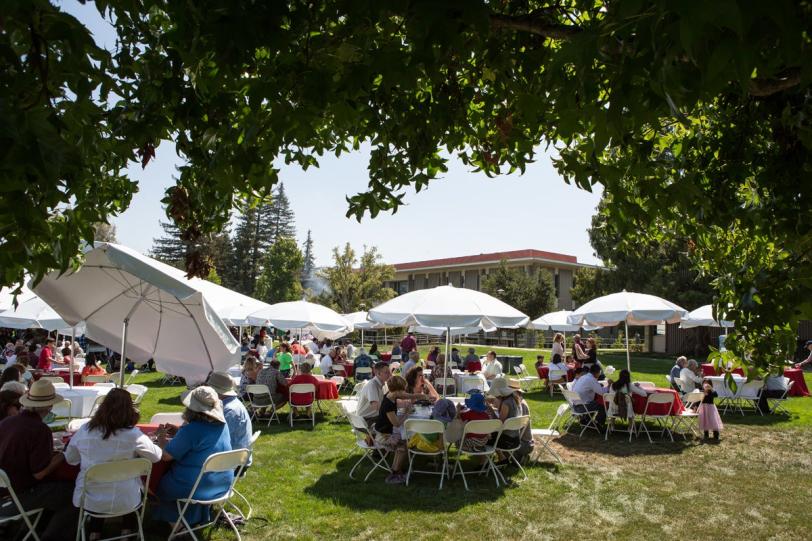
(Photo by Aubrie Pick)

(Photo by Aubrie Pick)